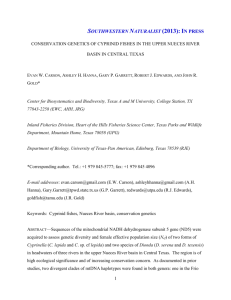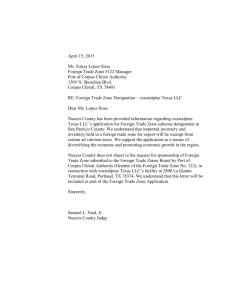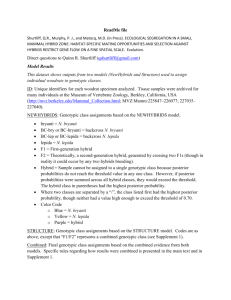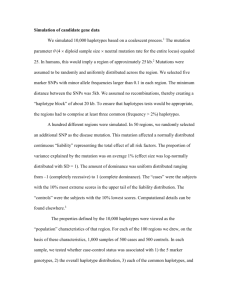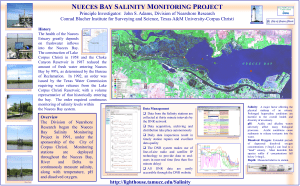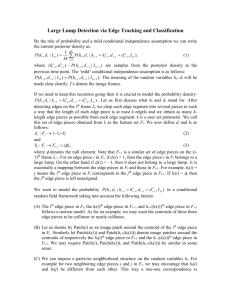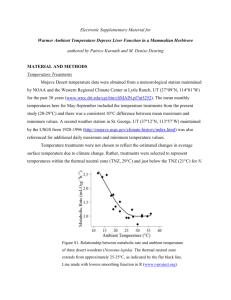Conservation genetics of cyprinid fishes in the upper Nueces River
advertisement
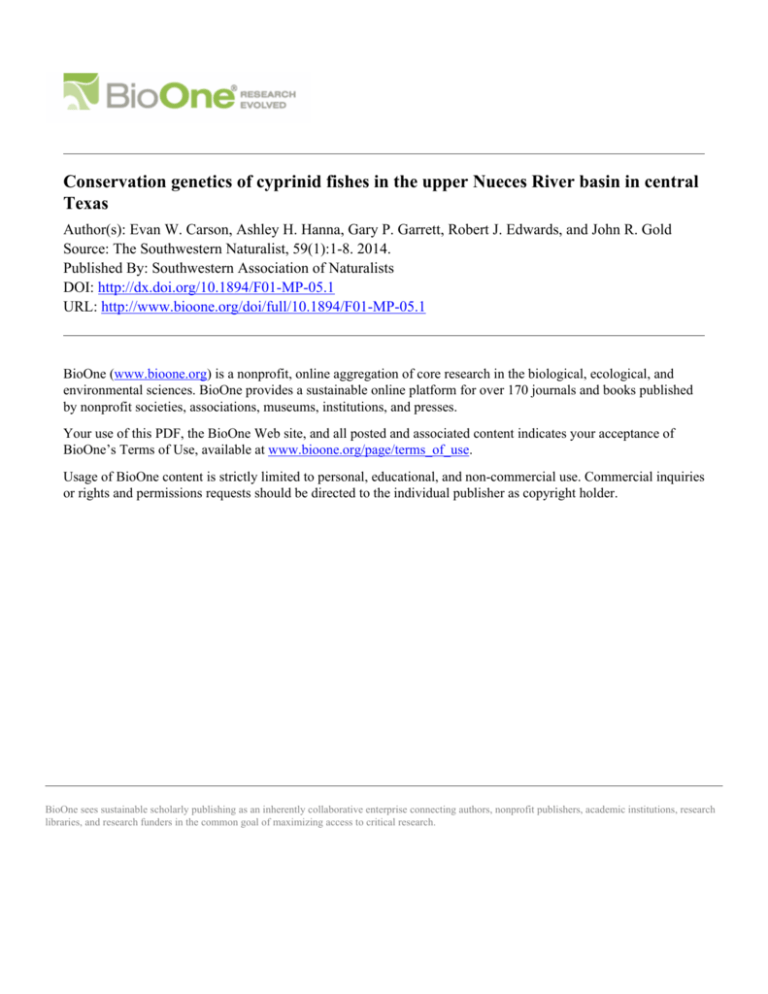
Conservation genetics of cyprinid fishes in the upper Nueces River basin in central Texas Author(s): Evan W. Carson, Ashley H. Hanna, Gary P. Garrett, Robert J. Edwards, and John R. Gold Source: The Southwestern Naturalist, 59(1):1-8. 2014. Published By: Southwestern Association of Naturalists DOI: http://dx.doi.org/10.1894/F01-MP-05.1 URL: http://www.bioone.org/doi/full/10.1894/F01-MP-05.1 BioOne (www.bioone.org) is a nonprofit, online aggregation of core research in the biological, ecological, and environmental sciences. BioOne provides a sustainable online platform for over 170 journals and books published by nonprofit societies, associations, museums, institutions, and presses. Your use of this PDF, the BioOne Web site, and all posted and associated content indicates your acceptance of BioOne’s Terms of Use, available at www.bioone.org/page/terms_of_use. Usage of BioOne content is strictly limited to personal, educational, and non-commercial use. Commercial inquiries or rights and permissions requests should be directed to the individual publisher as copyright holder. BioOne sees sustainable scholarly publishing as an inherently collaborative enterprise connecting authors, nonprofit publishers, academic institutions, research libraries, and research funders in the common goal of maximizing access to critical research. THE SOUTHWESTERN NATURALIST 59(1): 1–8 MARCH 2014 CONSERVATION GENETICS OF CYPRINID FISHES IN THE UPPER NUECES RIVER BASIN IN CENTRAL TEXAS EVAN W. CARSON, ASHLEY H. HANNA, GARY P. GARRETT, ROBERT J. EDWARDS, AND JOHN R. GOLD* Center for Biosystematics and Biodiversity, Texas A&M University, College Station, TX 77843-2258 (EWC, AHH, JRG) Inland Fisheries Division, Heart of the Hills Fisheries Science Center, Texas Parks and Wildlife Department, Mountain Home, TX 78058 (GPG) Department of Biology, University of Texas-Pan American, Edinburg, TX 78539 (RJE) Present address of EWC: Department of Biology and Museum of Southwestern Biology, University of New Mexico, MSC03 2020, 1 University of New Mexico Way, Albuquerque, NM 87131 Present address of JRG: Marine Genomics Laboratory, Harte Research Institute, Texas A&M University-Corpus Christi, 6300 Ocean Drive, Corpus Christi, TX 78412 *Correspondent: goldfish@tamucc.edu ABSTRACT—Sequences of the mitochondrial (mt) NADH dehydrogenase subunit 5 gene (ND5) were acquired to assess genetic diversity and female effective population size (Nef) of two forms of Cyprinella (C. lepida and C. sp. cf lepida) and two species of Dionda (D. serena and D. texensis) in headwaters of three rivers in the upper Nueces River basin in central Texas. As documented in prior studies, two divergent clades of haplotypes of mtDNA were found in both genera: one in the Frio and Sabinal rivers, representing C. lepida and D. serena; one in the Nueces River, representing C. sp. cf lepida and D. texensis. Levels of variation in mtDNA from C. lepida in the Sabinal River and D. serena in the Frio and Sabinal rivers were comparable to or considerably lower than values documented for populations of several threatened or endangered cyprinids. Estimates of Nef for C. lepida in the Frio River and C. sp. cf lepida in the Nueces River were low, suggesting that adaptive genetic variation through time may be compromised. Of all populations sampled, only D. texensis in the Nueces River appears at present to be genetically stable demographically. An unexpected finding was two individuals resembling C. lepida in the Frio River with a haplotype referable to C. sp. cf lepida; the origin of these individuals is unknown. Two other individuals resembling C. lepida but with haplotypes of mtDNA referable to C. venusta were found in the Frio River and presumably represent relatively recent hybrids. Results of our study indicate that C. lepida, C. sp. cf lepida, and D. serena in the upper Nueces River basin, especially in the Sabinal River drainage, are at appreciable genetic risk. RESUMEN—Secuencias de la subunidad 5 del gen mitocondrial NADH deshidrogenasa (ND5) se tomaron para evaluar la diversidad genética y el tamaño efectivo de la población femenina de dos formas de Cyprinella (C. lepida y C. sp. cf lepida) y dos especies de Dionda (D. serena y D. texensis) en las cabeceras de tres rı́os en la alta cuenta del rı́o Nueces en el centro de Texas. Como en previos estudios, se observaron dos clades divergentes en los haplotypos mitocondriales en cada género: uno en los rı́os Frio y Sabinal, representando C. lepida y D. serena, y otro en el rı́o Nueces, representando C. sp. cf lepida y D. texensis. Niveles de variación en las secuencias mitocondriales de C. lepida en el rı́o Sabinal y de D. serena en los rı́os Frio y Sabinal fueron comparables o menores a los documentados de poblaciones de varias otras especies de cyprinidos en peligro de extinción. Estimaciones del tamaño efectivo de la población femenina (Nef) para C. lepida en el rı́o Frio y C. sp. cf. lepida en el rı́o Nueces fueron pequeñas, lo cual sugiere que la variación genética adaptativa puede ser comprometida en el futuro. De todas las poblaciones muestreadas, sólo la población de D. texensis en el rı́o Nueces parece demostrar una demografı́a actual estable a nivel genético. Un resultado inesperado fue encontrar dos individuos que se parecı́an a C. lepida en el rı́o Frı́o con haplotypos referibles a C. sp. cf lepida; el origen de estos individuos es desconocido. Otros dos individuos que se parecı́an a C. lepida pero con haplotypos referibles a C. venusta también se encontraron en el rı́o Frio y probablemente representan hı́bridos relativamente recientes. Los resultados de nuestro estudio indican que las poblaciones de C. lepida, C. sp cf lepida, y D. serena en la alta cuenca del rı́o Nueces, especialmente en el desagüe del rı́o Sabina, están comprometidas genéticamente. 2 The Southwestern Naturalist The upper Nueces River basin in central Texas is an area of high priority for conservation because it hosts a high number of endemic plants and animals (The Nature Conservancy, http://www.nature.org/wherewework/ northamerica/states/texas/files/edwardsplateauexecsum. pdf; Texas Wildlife Action Plan, http://www.tpwd.state.tx. us/publications/pwdpubs/pwd_pl_w7000_1187a/). The area is dominated by the Nueces, Frio, and Sabinal rivers, with the upper portions of the basin separated from middle and lower segments by the Balcones Escarpment, a geologic fault zone several kilometers wide that separates the Edwards Plateau from the Gulf Coastal Plain (P. L. Abbott and C. M. Woodruff, in litt., http://www.lib.utexas. edu/geo/balcomes_escarpment/balconesescarpment. html). These headwater systems are ecologically distinct from reaches below the escarpment, including the confluence of the three rivers. Endemic and apparently imperiled headwater species in the genera Cyprinella and Dionda are among the species limited by this ecological barrier. Studies of endemic aquatic vertebrates in the region primarily have involved species in the cyprinid genera Cyprinella and Dionda. Matthews (1987) described the plateau shiner, Cyprinella lepida, based primarily on specimens from the Nueces River. Subsequent studies (Richardson and Gold, 1995; Broughton and Gold, 2000) found that clades of mitochondrial (mt) DNA haplotypes of C. lepida in the upper basin were not monophyletic; one clade occurred in the Frio and Sabinal rivers, while a second, distantly related clade occurred in the Nueces River. Schönhuth and Mayden (2010) showed that the mtDNA clade in the Frio River was related to mtDNA of Cyprinella formosa and lineages of Cyprinella lutrensis from the Mississippi and upper Rio Grande river drainages, while the mtDNA clade in the Nueces River was related to mtDNA in lineages of C. lutrensis (now Cyprinella suavis) from the Gulf Slope. Phylogenetic analysis of sequences of the nuclear genes Rag1 (Schönhuth and Mayden, 2010) and Hoxc6a (Broughton et al., 2011) in a few individuals from the Nueces and Frio rivers, however, indicated monophyly of C. lepida from the two rivers, with that clade having affinities to C. formosa and lineages of C. lutrensis. In part because of nomenclatorial issues (Hubbs, 1954), C. lepida currently is used to refer to fish resembling C. lepida in the Frio and Sabinal rivers, whereas C. sp. cf lepida is used to refer to fish resembling C. lepida in the Nueces River (http://www.bio.txstate. edu/~tbonner/txfishes/cyprinella%20lepida.htm). The systematics of Dionda in the upper Nueces River basin is less complex. Mayden (1992), based on allozymes, resurrected the name Dionda serena for specimens of Dionda from the Nueces and Frio rivers, and Schönhuth et al. (2012), based on mitochondrial and nuclear DNA sequences, resurrected the name Dionda texensis for Dionda in the Nueces River. Monophyly of D. serena and D. texensis is supported by sequences of mitochondrial and vol. 59, no. 1 nuclear genes (Schönhuth et al., 2008; Schönhuth et al., 2012). Threats to endemic fauna in the upper Nueces basin include many of the usual suspects: development; erosion; human disturbance; fragmentation (Texas Wildlife Action Plan). Many existing headwater and springassociated communities in the region have been damaged by persistent drought and groundwater withdrawal (Garrett and Edwards, 2001), and the current, exceptional drought, which is the most severe drought in the recorded history of Texas (http://www.window.state.tx. us/specialrpt/drought/pdf/96-1704-Drought.pdf), has led to an even greater risk of deterioration of habitat and water-quality. One consequence of such impacts is the present decline in both Cyprinella and Dionda in the upper basin, especially in the Sabinal River (G. P. Garrett and R. J. Edwards, pers. observ.). In our study, DNA sequences of the mitochondrial protein-coding NADH dehydrogenase subunit 5 gene (ND5) were acquired to assess the genetic diversity and female effective population size (Nef) of populations of C. lepida, C. sp. cf lepida, and Dionda in headwaters of the three rivers in the upper Nueces basin. Effective population size (Ne) is the number of breeding individuals in an idealized population that experiences the same rate of genetic drift or inbreeding as the population under consideration (Wright, 1931); because mtDNA is maternally inherited, Nef represents the female component of Ne. Consideration of effective size is of importance in conservation because low estimates of Ne can reflect fixation of deleterious alleles, loss of adaptive genetic variance, and the capacity to respond to natural selection or to environmental pressures such as degradation of habitat (Franklin, 1980; Frankham, 1995; Anderson, 2005). We chose to examine mtDNA, in part, because the genetic effective size of this locus in theory is four times less than that of nuclear DNA (Birky et al., 1989), meaning that population bottlenecks leading to reduced genetic variation and (female) effective size can be more easily detected than with nuclear-encoded DNA, in part because the mtDNA clades in the three rivers were thought to be fixed (Broughton et al., 2011) and, in part, because limited funding precluded more expensive microsatellite development and genotyping. MATERIALS AND METHODS—Specimens from the Frio, Sabinal, and Nueces rivers (Fig. 1) were collected by seine and preserved whole in 95% ethanol. Collections of Cyprinella were made at single localities in the Frio (26 specimens at 29850 0 14.48 00 N, 99846 0 40.66 00 W), Nueces, (23 specimens at 29848 0 42.24 00 N, 10080 0 56.45 00 W), and Sabinal (20 specimens at 29831 0 0.59 00 N, 99830 0 31.37 00 W) rivers. Collections of D. serena in the Frio River were made at two localities ca. 25 river-km apart (four specimens at 29850 0 14.48 00 N, 99846 0 40.66 00 W and 17 specimens at 29837 0 49.08 00 N, 99844 0 41.50 00 W); collections from the Nueces (24 specimens at 29848 0 42.24 00 N, 10080 0 56.45 00 W) and Sabinal (20 specimens at ca. 29848 0 27.72 00 N, 99834 0 14.26 00 W) rivers were March 2014 Carson et al.—Genetics of cyprinid fishes 3 QIAquick Gel Extraction kit (Qiagen, Valencia, California). Sequencing reactions were conducted with the L12328 (forward) primer and Big Dye terminators (Applied Biosystems, Foster City, California); an ABI 3100 (Applied Biosystems, Foster City, California) was used for DNA-sequencing. SEQUENCHER 4.1 (Gene Codes, Ann Arbor, Michigan) was used to align sequences; protein-coding was verified using MEGA4 (Tamura et al., 2007). Phylogenetic hypotheses from sequences of ND-5 were generated using neighbor-joining and maximum-parsimony methods, as implemented in Mega4. The Jukes-Cantor model of nucleotide substitution was used for neighbor-joining; the heuristic search option, with 10 random-addition replicates, was used for maximum parsimony. Robustness of inferred relationships was assessed via 1,000 bootstrap pseudo-replicates. Out- Fig. 1—Map of the upper Nueces River basin, including headwaters of the Frio, Nueces, and Sabinal rivers. Circles denote collections of Cyprinella lepida (open) and C. sp. cf lepida (solid); triangles identify collections of Dionda serena (open) and D. texensis (solid). Numbers within shapes represent sample sizes within rivers obtained for each species. made at single locations. Substantial effort was made to collect fish at various locations in each headwater area, but low abundance of Cyprinella and Dionda restricted geographic coverage in each system. In fact, sampling at each locality required multiple hauls of seines at each primary site just to obtain at least 15–20 individuals at most sites. Representative specimens were deposited in the Biodiversity Research and Teaching Collections at Texas A&M University, College Station (voucher numbers given in Appendix). Samples of D. serena from the Sabinal River were procured nondestructively (finclips) due to concerns over the small census-size of this population. Genomic DNA was extracted using the phenol-chloroform protocol of Sambrook et al. (1989). A 597 base-pair (bp) fragment of the mitochondrial protein-coding NADH dehydrogenase subunit-5 gene (ND-5) was amplified from each fish, using polymerase chain reaction (PCR) amplification. Primers L12328 (5 0 -AACTCTTGGTGCAAMTCCAAG-3 0 ) and H13393 (5 0 -CCTATTTTKCGGATGTCTTGYTC-3 0 ), developed by Miya et al. (2006), were used to amplify fragments of ND-5 from Cyprinella; primers L12328 (Miya et al., 2006) and DS-H (5 0 AAAAATTTGTTGAATTTCTCAGGA-3 0 , developed in our laboratory) were used for Dionda. The terminal 12 bp at the 3 0 -end of the fragment were difficult to score consistently; therefore, sequences were trimmed to yield 585-bp fragments that could be scored reliably. Conditions of amplification were 958C for 3 min, 35 cycles of 958C for 45 s, 508C for 30 s, 728C for 1 min, with a final 10-min extension at 728C. Products of amplification were cleaned with ExoSap-It (US Biological, Swampscott, Massachusetts) and electrophoresed on 2% agarose gels; target fragments were then obtained via band-cutting and cleaned using a TABLE 1—Spatial distribution of mtDNA haplotypes among Cyprinella and Dionda sampled from the Sabinal, Frio, and Nueces rivers in central Texas. Haplotype 5 recovered in Cyprinella from the Frio River has phylogenetic affinity to the mtDNA clade of C. sp. cf lepida from the Nueces River; haplotypes 11 and 12 are of C. venusta origin. River Haplotype Sabinal Frio Nueces GenBank Cyprinella 1 2 3 4 5 6 7 8 9 10 11 12 20 - 9 7 5 1 2 1 1 8 10 1 2 1 1 - HQ338512 HQ338513 HQ338514 HQ338515 HQ338516 HQ338517 HQ338518 HQ338519 HQ338520 HQ338521 HQ338522 HQ338523 Dionda 1 2 3 4 5 6 7 8 9 10 11 12 13 14 15 16 17 18 19 20 - 17 1 1 1 1 7 3 2 2 1 1 1 1 1 1 1 1 1 1 - GU252323 GU252324 GU252325 GU252326 GU252327 GU252328 GU252329 GU252330 GU252331 GU252332 GU252333 GU252334 GU252335 GU252336 GU252337 GU252338 GU252339 GU252340 GU252341 4 The Southwestern Naturalist group taxa (and their GenBank Accession Numbers) are given in Appendix. Number and diversity of haplotypes and diversity of nucleotides at each sampled locality were generated using DNASP version 5.10.01 (Rozas et al., 2003); haplotype richness was estimated using FSTAT version 2.9.3.2 (Goudet, 1995). Pairwise genetic distances between haplotypes were calculated in MEGA4, using the Jukes-Cantor model of nucleotide substitution. Homogeneity of number and diversity of haplotypes was tested through the bootstrap method of Dowling et al. (1996), with resampling conducted in PopTools (http://www.poptools. org/). Homogeneity in distribution of mtDNA haplotypes was tested using exact tests and analysis of molecular variance (AMOVA), as implemented in ARLEQUIN version 3.5 (Excoffier and Lischer, 2010). Pairwise estimates of UST, an analogue of FST, were generated using ARLEQUIN, with significance determined by exact tests (Raymond and Rousset, 1995; Goudet et al., 1996). Sequential Bonferroni correction (Rice, 1989) was used to adjust for multiple tests executed simultaneously. Maximum-likelihood estimates of average, long-term Nef were generated using the coalescent-based Markov chain, Monte Carlo approach in LAMARC version 2.1.5 (Kuhner, 2006; Kuhner and Smith, 2007), under the assumption of a mutation rate of 1% per million years and using the formula Nef = h/2l as appropriate for a haploid, maternally-inherited locus. Coalescent-based estimates of Ne are fairly insensitive to small sample sizes comparable to those obtained for this study (https:// biotech.inbre.alaska.edu/fungal_portal/program_docs/ lamarc/index.html) but are nonetheless subject to relatively large variances when derived from single loci such as mtDNA. Initial analyses implemented default settings to explore parameters suitable for final sampling strategies of the coalescentbased Markov chain, Monte Carlo approach. Final analyses included three replicates, using the following Markov-chain parameters: an initial analysis of 10 short chains, with 20,000 genealogies sampled, the first 2,000 of which were discarded to ensure parameter stability; a final analysis of three long chains, with 2.5 · 106 genealogies sampled and the first 25,000 trees discarded. Although generation times for Cyprinella and Dionda are not well established, life-history data on other North American cyprinids (Harrell and Cloutman, 1978; Cloutman and Harrell, 1987) indicate that a generation time between 2 and 3 years is reasonable; therefore, estimates of Nef were based on 2-year and 3-year generation times. RESULTS—Twelve unique mtDNA haplotypes were found among 69 specimens of Cyprinella, whereas 19 haplotypes were found among 65 specimens of Dionda (Table 1). Most haplotypes of Cyprinella were recovered in two strongly supported clades (Fig. 2a); one clade contained four haplotypes found in the Sabinal and Frio rivers (C. lepida), while the other was composed of six haplotypes found in the Nueces River (C. sp. cf lepida), one of which (haplotype 5) also was found in two individuals from the Frio River. In addition, two haplotypes recovered from the Frio River (haplotypes 11 and 12, Table 1) aligned (100% bootstrap support) with a haplotype of Cyprinella venusta. The three distinct haplotypes recovered from the Frio River (haplotype 5, vol. 59, no. 1 Fig. 2—Neighbor-joining topologies for a) Cyprinella and b) Dionda. Numbers above and below branches indicate bootstrap support for neighbor-joining and maximum-parsimony trees, respectively. Genetic distance is indicated by the scale in the lower right corner of each tree. related to haplotypes in the Nueces River, and haplotypes 11 and 12, related to C. venusta) were omitted from subsequent analyses. Sequence-divergence among haplotypes within clades ranged from 0.2–0.5% (C. lepida) and 0.2–0.9% (C. sp. cf lepida); sequence-divergence between haplotypes in the two clades ranged from 14.5–15.3%. The two clades were not sister to one another, because a haplotype of C. lutrensis from Kansas, which belongs to a clade of C. lutrensis from the Mississippi and upper Rio Grande drainages (Schönhuth and Mayden, 2010), was sister to the clade containing haplotypes from the Frio and Sabinal rivers (C. lepida). Haplotypes of Dionda also separated into two distinct, strongly supported clades (Fig. 2b); one contained five haplotypes recovered from the Frio and Sabinal rivers (D. serena), whereas the other contained 14 haplotypes from the Nueces River (D. texensis). Sequence-divergence among haplotypes within March 2014 Carson et al.—Genetics of cyprinid fishes each clade ranged from 0.2–0.5% (D. serena) and 0.2– 1.2% (D. texensis); sequence-divergence between haplotypes in the two clades ranged from 3.9–4.9%. A sistergroup relationship between two clades was strongly supported (100% bootstrap). Summary statistics of mtDNA variation for the two genera in each river system are given in Table 2. Cyprinella lepida from the Sabinal River had significantly lower number (1) and diversity (0.0) of haplotypes than expected in comparable, random samples of C. lepida from the Frio River (expected HN = 3.6, 95% confidence interval, CI, = 3–4; expected HD = 0.86, 95% CI = 0.69– 0.96) and C. sp. cf lepida from the Nueces River (expected HN = 4.6, 95% CI = 3–6; expected HD = 0.77, 95% CI = 0.61–0.89). Number (4) and diversity (0.71) of haplotypes from C. lepida in the Frio River did not differ significantly from that in a comparable, random sample of C. sp. cf lepida from the Nueces River (expected HN = 4.7, 95% CI = 3–6; expected HD = 0.78, 95% CI = 0.62–0.91). The same approach revealed that D. serena from the Sabinal River had a significantly lower number (1) and diversity (0.0) of haplotypes than expected in comparable, random samples of D. serena from the Frio River (expected HN = 3.5, 95% CI = 2–5; expected HD = 0.39, 95% CI = 0.12–0.72) and D. texensis from the Nueces River (expected HN = 9.3, 95% CI = 7–12; expected HD = 0.94, 95% CI = 0.85–0.99) and that D. serena from the Frio River had a significantly lower number (5) and diversity (0.35) of haplotypes than expected in a comparable, random sample of D. texensis from the Nueces River (expected HN = 9.5, 95% CI = 7–12; expected HD = 0.94, 95% CI = 0.84–0.99). Although difficult to test statistically, nucleotide diversity (pD) in D. serena from the Frio River (pD = 0.0008) was slightly less than one-fifth of that observed for D. texensis (pD = 0.0044). Significant heterogeneity in distributions of haplotypes among the three rivers (both lineages) was detected by exact tests (P < 0.001, Cyprinella; P = 0.001, Dionda) and by AMOVA (UST = 0.983, P < 0.001, Cyprinella; UST = 0.934, P < 0.001, Dionda). Pairwise estimates of UST and probabilities of UST (<0.001) indicated highly divergent distributions of haplotypes (both genera) between fish from either the Frio or Sabinal rivers compared to fish in the Nueces River (UST values of 0.984 and 0.989 in Cyprinella and 0.933 and 0.941 in Dionda). Values of UST in comparisons between the Frio and Sabinal rivers were significant for Cyprinella (UST = 0.200, P < 0.001) but nonsignificant for Dionda (UST = -0.002, P > 0.05). Estimates of average, long-term Nef for C. lepida (Frio River) and C. sp. cf lepida (Nueces River) ranged from 112.5–75.0 and 298.9–199.3, respectively; whereas estimates for D. texensis ranged from 5,725.1–3,816.7. The absence of variation in mtDNA haplotypes of C. lepida and D. serena from the Sabinal River and the skewed distribution and low diversity of haplotypes of D. serena in the Frio River (Table 2) precluded reliable estimation 5 Table 2—Summary statistics of variation in mtDNA among samples of Cyprinella and Dionda from the Sabinal, Frio, and Nueces rivers in central Texas. Abbreviations denote sample size (n), number of haplotypes (HN), haplotype richness (HR), haplotype (nucleon) diversity (HD), and nucleotide diversity (pD). River Statistic Sabinal Frio Nueces Cyprinella n HN HR HD pD 20 1 1 0 0 22 4 3.99 0.710 0.0017 23 6 5.96 0.708 0.0028 Dionda n HN HR HD pD 20 1 1 0 0 21 5 4.99 0.352 0.0008 24 14 13.75 0.906 0.0044 of Nef for these three samples. The 95% confidence intervals for each estimate of Nef were fairly broad, such that the estimates for C. lepida (Frio River; 33.6–722.9 and 22.4–481.9) and C. sp. cf lepida (81.7–1,758.3 and 54.5– 1,172.2) did not differ significantly from each other; the estimates of Nef for C. lepida (Frio River) and C. sp. cf lepida, however, were well outside the lower 95% confidence limit of the estimate of Nef for D. texensis (905.8-‘ and 603.8-‘). The lower 95% confidence limits for Cyprinella from the Frio and Nueces rivers were <100 for both estimates of generation time. DISCUSSION—All studies to date of mtDNA of fishes resembling C. lepida in the upper Nueces basin have found two nonmonophyletic mtDNA clades: one in the Frio and Sabinal rivers (C. lepida); one in the Nueces River (C. sp. cf lepida). Haplotypes in the two clades differ in ND5 sequences by 14.5–15.3%. Assuming, for heuristic purposes, an evolutionary rate of ND5 between 0.75 and 1.00% per lineage per million years based on estimates for cytochrome b in cyprinids (Dowling et al., 2002) and the observation (Meyer, 1994) that NADH-dehydrogenase subunit genes evolve faster than other mitochondrial protein-coding genes, the two mtDNA clades likely have been evolving independently for over 7 million years. Phylogenetic analyses of mtDNA and the nuclear genes Rag1 (Schönhuth and Mayden, 2010) and Hoxc6a (Broughton et al., 2011) from several lineages of Cyprinella are consistent with the hypothesis that the mtDNA clade in the Frio and Sabinal rivers represents the ancestral mtDNA of C. lepida, while that in the Nueces River represents introgression of mtDNA from a lineage resembling C. lutrensis inhabiting Gulf Slope drainages, 6 The Southwestern Naturalist most likely Cyprinella suavis (Schönhuth and Mayden, 2010). By our count from all published papers, the 42 fish resembling C. lepida thus far examined from the Nueces River belong to one mtDNA clade, whereas 72 of 76 fish resembling C. lepida examined from the Frio and Sabinal rivers belong to the second mtDNA clade. The four exceptions, found in samples from the Frio River in this study, are two individuals that possessed a haplotype of C. sp. cf lepida and two individuals with haplotypes referable to C. venusta. The latter is not surprising because C. venusta occurs in the Frio River and hybridization between C. venusta and fish resembling C. lutrensis is common and well documented (Hubbs and Strawn, 1956; Broughton et al., 2011). Occurrence of a haplotype of C. sp. cf lepida in the Frio River is another matter as prior studies (e.g., Broughton et al., 2011) generally have assumed that the two mtDNA clades are fixed in their respective localities and that the putative hybridization between C. lepida (or its direct progenitor) and a fish resembling C. suavis occurred only in the Nueces River. Alternatively, the haplotype of C. sp. cf lepida could represent a remnant in the Nueces River from transplants by anglers using cyprinids as bait for sunfish (Lepomis), largemouth bass (Micropterus), and channel catfish (Ictalurus punctatus). Anecdotally, such transplants in the Nueces basin were not uncommon in the past (GPG, pers. observ.), and the two rivers in the upper basin are generally <25 km apart by road. One other possibility is historical capture of headwaters between the two rivers (Hill, 1898). Testing any of these possibilities will be problematic. Mitochondrial DNA haplotypes in Dionda formed two distinct, strongly supported mtDNA clades, one in the Frio and Sabinal rivers (D. serena) and one in the Nueces River (D. texensis). These results are fully consistent with separation into two species as proposed by Schönhuth et al. (2012). Number (normalized in relation to sample size) and diversity of haplotypes were significantly reduced in C. lepida and D. serena from the Sabinal River where only a single haplotype was found in each species. Estimates of both parameters did not differ significantly between C. lepida (Frio River) and C. sp. cf lepida, whereas estimates of both parameters did differ significantly in pairwise comparisons among Dionda from all three rivers and following the pattern Nueces > Frio > Sabinal. Number (14 versus 5) and diversity (0.906 versus 0.352) of haplotypes were nearly three times greater for D. texensis than for D. serena (Frio River). In addition, diversity of nucleotides (the average number of nucleotide differences per site between any two DNA sequences chosen randomly) was more than five times greater in D. texensis, indicating that Dionda in the Nueces River has been more stable demographically in recent times, is undergoing expansion relative to Dionda in the other two rivers, or vol. 59, no. 1 both. Also, the estimates of diversity of mtDNA haplotypes in C. lepida and D. serena from the Sabinal River and D. serena from the Frio River are comparable to or considerably lower than values documented for populations of several threatened or endangered cyprinids, including Anaecypris hispanica (Alves et al., 2001), Notropis mekistocholas (Saillant et al., 2004), Hybognathus amarus (Alò and Turner, 2005), Notropis simus pecosensis (M. Osborne and T. F. Turner, in litt., http://www.wildlife. state.nm.us/conservation/share_with_wildlife/ documents/06Osborne.pdf), and several species in the genus Gila (T. Dowling, pers. comm.). The absence of variation in haplotypes of mtDNA in C. lepida and D. serena in the Sabinal River and the low and asymmetric variation in haplotypes in D. serena from the Frio River precluded estimation of average, long-term Nef for these populations. Estimates of Nef for C. lepida (Frio River) and C. sp. cf lepida did not differ from one another based on 95% confidence limits. However, the lower 95% confidence intervals for both populations of Cyprinella and at both generation times considered were <100, and, to the extent that lower confidence intervals for estimates of effective size should be considered informative (Waples and Do, 2010), both populations may have suffered high rates of genetic drift in their past and may now lack the genetic diversity to successfully adapt to environmental change. Average, long-term estimates of Nef for D. texensis exceeded 3,000, consistent with the demography of a presently stable population, given that long-term estimates of Ne represent an average of Ne over approximately 2Ne generations (Hare et al., 2011). Distributions of haplotypes of mtDNA differed significantly among Cyprinella sampled from each of the three rivers, with the degree of difference (FST ‡ 0.980) greatest between Cyprinella from the Nueces River (C. sp. cf lepida) versus those from the Sabinal and Frio rivers (C. lepida). The estimated FST for the comparison of C. lepida from the Sabinal River versus those from the Frio River was 0.200 and differed significantly from zero; the difference, however, was largely a reflection of haplotype 1 occurring in all 20 fish from the Sabinal River but in only nine of 22 (41%) fish from the Frio River. Minimally, there are two genetically distinct populations of fish resembling C. lepida in the upper Nueces River basin, one in the Nueces River (C. sp. cf lepida) and one in the Sabinal and Frio rivers (C. lepida); both should be considered as separate units of management (sensu Moritz, 1994). Homogeneity tests of distributions of haplotypes of mtDNA among the three rivers yielded essentially the same results for Dionda. Estimates of FST between D. serena (Frio and Sabinal rivers) and D. texensis were ‡0.933, whereas the estimate of FST for the comparison between D. serena in the Sabinal and Frio rivers did not differ from zero. The foregoing indicates that, except for Dionda in the Nueces River (D. texensis), D. serena and fish resembling C. lepida in the upper Nueces River basin, especially in the March 2014 Carson et al.—Genetics of cyprinid fishes Sabinal River, are at considerable genetic risk, as indicated by significantly reduced diversity in mtDNA and low, long-term Nef. Thus, present concern should place priority on continuation of surveys within the basin to identify and evaluate additional populations, should they exist. Also, given the challenges that human-induced perturbations typically present to imperiled species (Caro and Laurenson, 1994), it will be critical to assess how a predicted doubling of the human population in the basin over the next several decades (Texas Wildlife Action Plan) is likely to impact these unique natural resources. Finally, our study contributes to the growing concern for biota living in headwater streams (Meyer et al., 2007) and to the observations that headwater species of fish are particularly vulnerable to extirpation (Warren et al., 2000). One final point regards whether C. lepida and C. sp. cf lepida warrant designation as distinct species. As noted by Broughton et al. (2011), the central issue is whether introgression (and replacement) of mtDNA is sufficient to merit designation as a species. In our view, regardless of their evolutionary history, C. lepida and C. sp. cf lepida warrant some level of protection because both appear genetically compromised and genetically unique. We thank P. Fleming and K. Reeves for assistance with collection of material, R. Gibson for providing samples of D. serena from the Sabinal River, M. Renshaw for technical assistance in the laboratory, and C. Santamaria and E. Taylor for help with the Spanish translation of the abstract. Work was supported by State Wildlife Grant 199634 of the Texas Parks and Wildlife Department (to JRG), Grant RXFO-062706 of The Nature Conservancy of Texas (to RJE), and H-6703 of Texas AgriLife Research. Views presented do not necessarily reflect those of the Texas Parks and Wildlife Department. This paper is contribution 250 of the Center for Biosystematics and Biodiversity at Texas A&M University, College Station. LITERATURE CITED ALÒ, D., AND T. F. TURNER. 2005. Effect of habitat fragmentation on effective population size in the endangered Rio Grande silvery minnow. Conservation Biology 19:1,138–1,148. ALVES, M. J., H. COELHO, M. J. COLLARES-PEREIRA, AND M. M. COEHLO. 2001. Mitochondrial DNA variation in the highly endangered cyprinid fish Anaecypris hispanica: importance for conservation. Heredity 87:463–473. ANDERSON, E. C. 2005. An efficient Monte Carlo method for estimating Ne from temporally spaced samples using a coalescent-based likelihood. Genetics 170:955–967. BIRKY, C. W., P. FUERST, AND T. MARUYAMA. 1989. Organelle gene diversity under migration, mutation, and drift: equilibrium expectations, approach to equilibrium, effects of heteroplasmic cells, and comparison to nuclear. Genetics 121:613–627. BROUGHTON, R. E., AND J. R. GOLD. 2000. Phylogenetic relationships in the North American cyprinid genus Cyprinella (Actinopterigii: Cyprinidae) based on sequences of the mitochondrial ND2 and ND4L genes. Copeia 2000:1–10. BROUGHTON, R. E., K. C. VEDALA, T. M. CROWL, AND L. L. RITTERHOUSE. 2011. Current and historical hybridization with 7 differential introgression among three species of cyprinid fishes (genus Cyprinella). Genetica 139:699–707. CARO, T. M., AND M. K. LAURENSON. 1994. Ecological and genetic factors in conservation: a cautionary tale. Science 263:485– 486. CLOUTMAN, D. G., AND R. D. HARRELL. 1987. Life-history notes on the whitefin shiner, Notropis niveus (Pisces, Cyprinidae). Copeia 1987:1,037–1,040. DOWLING, T. E., W. L. MINCKLEY, P. C. MARSH, AND E. S. GOLDSTEIN. 1996. Mitochondrial DNA variability in the endangered razorback sucker (Xyrauchen texanus): analysis of hatchery stocks and implications for captive propagation. Conservation Biology 10:120–127. DOWLING, T. E., C. A. TIBBETS, W. L. MINCKLEY, AND G. R. SMITH. 2002. Evolutionary relationships of the plagopterins (Teleostei: Cyprinidae) from cytochrome b sequences. Copeia 2002:665–678. EXCOFFIER, L., AND H. E. L. LISCHER. 2010. Arlequin suite ver 3.5: a new series of programs to perform population genetics analyses under Linux and Windows. Molecular Ecology Resources 10:564–567. FRANKHAM, R. 1995. Effective population-size adult-population size ratios in wildlife: a review. Genetical Research 66:95–107. FRANKLIN, I. R. 1980. Evolutionary change in small populations. Pages 135–149 in Conservation biology: an evolutionaryecological perspective (M. E. Soulé and B. A. Wilcox, editors). Sinauer, Sunderland, Massachusetts. GARRETT, G. P., AND R. J. EDWARDS. 2001. Regional ecology and environmental issues. Pages 56–65 in Aquifers of West Texas. Proceedings of aquifers of West Texas symposium (R. E. Mace, W. F. Mullican, III, and E. S. Angle, editors). Texas Water Development Board, Report 356:1–272. GOUDET, J. 1995. F-STAT, a computer program to calculate FStatistics. Journal of Heredity 86:485–486. GOUDET, J., M. RAYMOND, T. DE MEEÜS, AND F. ROUSSET. 1996. Testing differentiation in diploid populations. Genetics 144:1,933– 1,940. HARE, M. P., L. NUNNEY, M. K. SCHWARTZ, D. E. RUZZANTE, M. BURFORD, R. S. WAPLES, K. RUEGG, AND F. PALSTRAA. 2011. Understanding and estimating effective population size for practical application in marine species management. Conservation Biology 25:438–449. HARRELL, R. D., AND D. G. CLOUTMAN. 1978. Distribution and life history of sandbar shiner, Notropis scepticus (Pisces, Cyprinidae). Copeia 1978:443–447. HILL, R. T., AND T. W. VAUGHAN. 1898. Geologic atlas of the United States, Nueces Folio, Texas. Folio 42. United States Geological Survey, Washington, D.C. HUBBS, C. 1954. Corrected distributional records for Texas freshwater fishes. Texas Journal of Science 1954:277–291. HUBBS, C., AND K. STRAWN. 1956. Interfertility between two sympatric fishes, Notropis lutrensis and Notropis venustus. Evolution 10:341–344. KUHNER, M. K. 2006. LAMARC 2.0: maximum likelihood and Bayesian estimation of population parameters. Bioinformatics 22:768–770. KUHNER, M. K., AND L. P. SMITH. 2007. Comparing likelihood and Bayesian coalescent estimation of population parameters. Genetics 175:155–165. MATTHEWS, W. J. 1987. Geographic variation in Cyprinella lutrensis (Pisces: Cyprinidae) in the United States, with notes on Cyprinella lepida. Copeia 1987:616–637. 8 The Southwestern Naturalist MAYDEN, R. L., R. H. MATSON, AND D. M. HILLIS. 1992. Speciation in the North American genus Dionda (Teleostei: Cypriniformes). Pages 710–746 in Systematics, historical ecology, and North American freshwater fishes (R. L. Mayden, editor). Stanford University Press, Stanford, California. MEYER, A. 1994. DNA technology and phylogeny of fish. Pages 219–249 in Genetics and Evolution of Aquatic organisms (A. R. Beaumont, editor). Chapman & Hall, London, United Kingdom. MEYER, J. L., D. L. STRAYER, J. B. WALLACE, S. L. EGGERT, G. S. HELFMAN, AND N. E. LEONARD. 2007. The contribution of headwater streams to biodiversity in river networks. Journal of the American Water Resources Association 43:86–103. MIYA, M., K. SAITOH, R. WOOD, N. NISHIDA, AND R. L. MAYDEN. 2006. New primers for amplifying and sequencing the mitochondrial ND4/ND5 gene region of the Cypriniformes (Actinopterygii: Ostariophysi). Ichthyological Research 53:75–81. MORITZ, C. 1994. Defining ’Evolutionarily Significant Units’ for conservation. Trends in Ecology and Evolution 9:373–375. RAYMOND, M., AND F. ROUSSET. 1995. An exact test for population differentiation. Evolution 49:1,280–1,283. RICHARDSON, L. R., AND J. R. GOLD. 1995. Evolution of the Cyprinella lutrensis species-complex II. Systematics and biogeography of the Edwards Plateau shiner, Cyprinella lepida. Copeia 1995:28–37. RICE, W. R. 1989. Analyzing tables of statistical tests. Evolution 43:223–225. ROZAS, J., J. C. SANCHEZ-DEL BARRIO, X. MESSEGUER, AND R. ROZAS. 2003. DNASP: DNA polymorphism analyses by the coalescent and other methods. Bioinformatics 19:2,496–2,497. SAMBROOK, J., E. F. FRITSCH, AND T. MANIATIS. 1989. Molecular cloning: a laboratory manual. Second edition. Cold Spring Harbor Laboratory Press, New York. SAILLANT, E., J. C. PATTON, K. E. ROSS, AND J. R. GOLD. 2004. Conservation genetics and demographic history of populations of critically endangered Cape Fear shiners, Notropis mekistocholas. Molecular Ecology 13:2,947–2,958. SCHÖNHUTH, S., AND R. L. MAYDEN. 2010. Phylogenetic relationships in the genus Cyprinella (Actinopterygii: Cyprinidae) based on mitochondrial and nuclear gene sequences. Molecular Phylogenetics and Evolution 55:77–98. SCHÖNHUTH, S., I. DOADRIO, O. DOMINGUEZ-DOMINGUEZ, D. M. HILLIS, AND R. L. MAYDEN. 2008. Molecular evolution of the southern North American Cyprinidae (Actinopterygii), with the description of the new genus Tampichthys from central Mexico. Molecular Phylogenetics and Evolution 47:729–756. vol. 59, no. 1 SCHÖNHUTH, S., D. M. HILLIS, D. A. NEELY, L. LOZANO-VILANO, A. PERDICES, AND R. L. MAYDEN. 2012. Phylogeny, diversity, and species delimitation of the North American round-nosed minnows (Teleostei: Dionda), as inferred from mitochondrial and nuclear DNA sequences. Molecular Phylogenetics and Evolution 62:427–446. TAMURA, K., J. DUDLEY, M. NEI, AND S. KUMAR. 2007. MEGA4: molecular evolutionary genetics analysis version 4.0. Molecular Biology and Evolution 24:1,596–1,599. WAPLES, R. S., AND C. DO. 2010. Linkage disequilibrium estimates of contemporary Ne using highly variable genetic markers: a largely untapped resource for applied conservation and evolution. Evolutionary Applications 3:244–262. WARREN, M. L., H. W. ROBISON, S. T. ROSS, W. C. STARNES, B. M. BURR, S. J. WALSH, H. L. BART, JR., R. C. CASHNER, D. A. ETNIER, B. J. FREEMAN, B. R. KUHAJDA, AND R. L. MAYDEN. 2000. Diversity, distribution, and conservation status of the native freshwater fishes of the Southern United States. Fisheries 25:7–31. WRIGHT, S. 1931. Evolution in Mendelian populations. Genetics 16:97–159. Submitted 4 September 2012. Acceptance recommended by Associate Editor Mark Pyron 28 January 2013. APPENDIX 1—Material examined. Specimens vouchered at the Biodiversity Research and Teaching Collections (BRTC), Texas A&M University, College Station. Cyprinella lepida, 14249.01–14253.01, 14405.01, 14406.01, 14408.01, and 14412.01–14424.01 (Sabinal River) and 14254.01–14261.01 and 14424.01–14441.01 (Frio River); Cyprinella sp. cf. lepida, 14262.01–14267.01 and 14442.01– 144457.01 (Nueces River); Dionda serena, 14268.01–14272.01 and 14461.01–14474.01 (Frio River), and Dionda texensis 14273.01–14286.01, 14475.01–14482.01, and 14484.01– 14485.01 (Nueces River). Because samples were taken nondestructively (fin-clips) from the Sabinal River drainage (Lost Maples State Park), this collection was not vouchered. Sequences obtained from GenBank (http://www.ncbi.nlm. nih.gov/genbank/). Outgroups to Cyprinella: Cyprinella lutrensis (NC008643.1); Cyprinella spiloptera (NC008103.1); Cyprinella venusta (HQ338524); Luxilus chrysocephalus (EF452753.1). Outgroups to Dionda: Dionda argentosa (GU252302); Dionda diaboli (GU252318); Dionda sp. 4 (GU252320); Dionda flavipinnis (GU252321); Campostoma anomalum (GU252342); Nocomis micropogon (GU252343).
